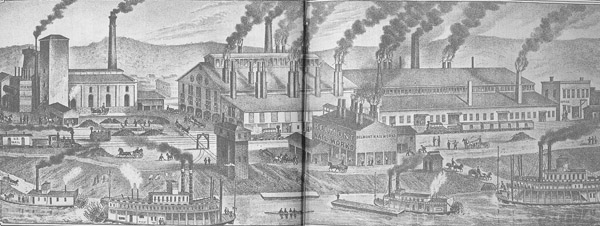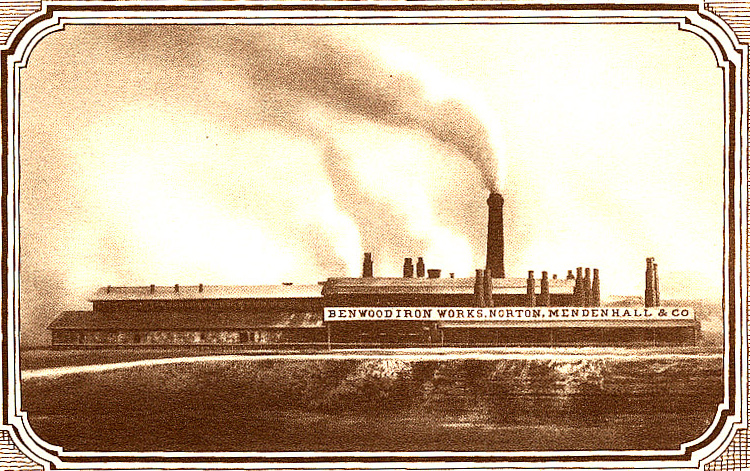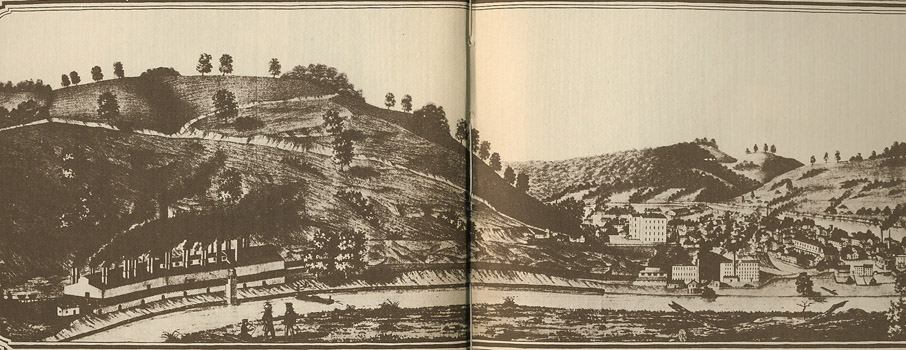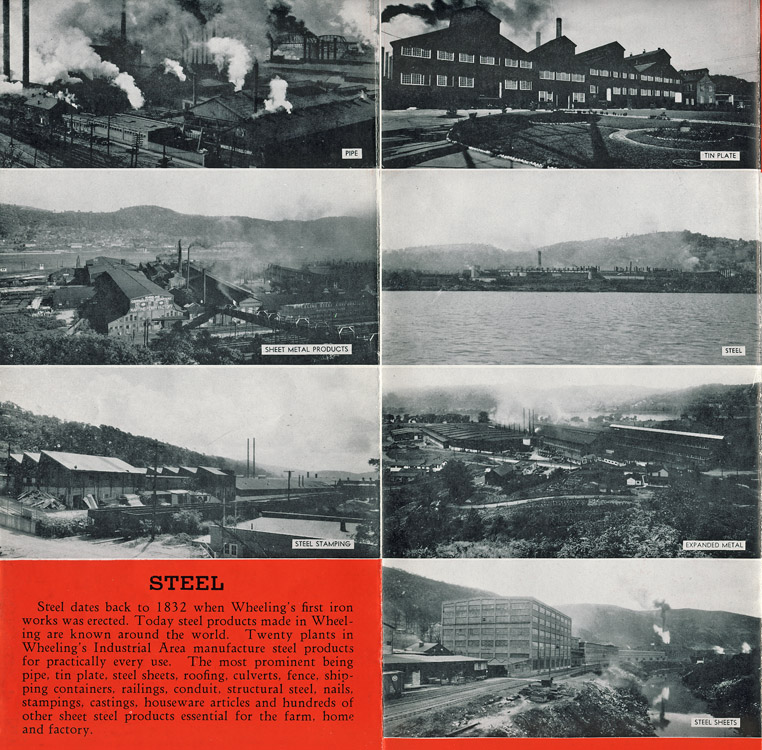Iron & Steel
From the 1870s through the 1950s Wheeling was a major producer of iron and steel and products made from them. Since that time the iron and steel industry has declined precipitously with only a few companies struggling to survive.
The early mills made some investors very wealthy, part of the reason being that labor costs were kept low by hiring boys as well as men. William Lewis, for example, started working at the Wheeling Iron Works at the age of 7! (Scott, 1929) So when you look at the stately Wheeling homes from the1870s and 1880s think of the children who worked in the mills.
1834: Philip Shoenberger and David Agnew built Wheeling's first iron mill - Wheeling Iron Works - making nails, until 1857. Shoenberger chose Wheeling because it had good transportation - the river - and plentiful coal in the nearby hills. The was no iron ore so he shipped pig iron from his factory in Pittsburgh and Wheeling produced products such as nails, sheets and pipe. (Scott, 1929)
1847: E. M. Norton and others organized the Virginia mill, to manufacture nails exclusively. It was located on the site of the B. & O. depot, and started with forty machines.
1849: Mr. Norton and others built the Belmont mill (below). Click here for larger image.

In this wonderful drawing the paddlewheel boat at the left is named Andes. Drawing of the mill in 1877 from (Scott, 1929)

1865 drawing from (Scott, 1929)
1853: the present Benwood mill was built as the successor of the Virginia mill, which had been removed to give room for the Baltimore & Ohio Company. The new Virginia mill was sold under a decree of court in 1864, and reorganized as the Benwood mill, E. M. Norton being its President. About the same time Cyrus Mendelhall entered the company, and it thus acquired his blast furnace at Martin's Ferry, and fifty acres of ore land near.
1852: Mr. E. C. Dewey built the Eagle wire mill, at the head of what is now Twenty-fifth street. In 1850 this works was burned, but rebuilt. In 1860 it was leased by O. C. Dewey, J. N. Vance and W. H. Russell, who, under the firm name of Dewey, Vance & Co., operated the Wheeling Iron and Spike works. From this beginning through various stages of progress has grown the Riverside Iron and Steel Works, one of the wealthiest and most important concerns of its kind in the country.
1852: The LaBelle mill was completed by Bailey, Woodward & Co.
Text rearranged slightly from Wheeling Intelligencer, 1896
Crescent Mill

drawing of mill in 1855 from (Scott, 1929)
The Crescent Mill was founded in 1854 by the the Crescent Iron Manufacturing Company, and in 1862 became the Whitaker Iron Company. During the Civil War the company made railway rails, but after 1872 converted to sheet iron. Coal was mined from the surrounding hills and slide down an incline to the mill.

Section of ~1936 Wheeling Chamber of Commerce brochure. Can someone identify which companies were in these buildings?
The early mills made some investors very wealthy, part of the reason being that labor costs were kept low by hiring boys as well as men. William Lewis, for example, started working at the Wheeling Iron Works at the age of 7! (Scott, 1929) So when you look at the stately Wheeling homes from the1870s and 1880s think of the children who worked in the mills.
1834: Philip Shoenberger and David Agnew built Wheeling's first iron mill - Wheeling Iron Works - making nails, until 1857. Shoenberger chose Wheeling because it had good transportation - the river - and plentiful coal in the nearby hills. The was no iron ore so he shipped pig iron from his factory in Pittsburgh and Wheeling produced products such as nails, sheets and pipe. (Scott, 1929)
1847: E. M. Norton and others organized the Virginia mill, to manufacture nails exclusively. It was located on the site of the B. & O. depot, and started with forty machines.
1849: Mr. Norton and others built the Belmont mill (below). Click here for larger image.

In this wonderful drawing the paddlewheel boat at the left is named Andes. Drawing of the mill in 1877 from (Scott, 1929)

1865 drawing from (Scott, 1929)
1853: the present Benwood mill was built as the successor of the Virginia mill, which had been removed to give room for the Baltimore & Ohio Company. The new Virginia mill was sold under a decree of court in 1864, and reorganized as the Benwood mill, E. M. Norton being its President. About the same time Cyrus Mendelhall entered the company, and it thus acquired his blast furnace at Martin's Ferry, and fifty acres of ore land near.
1852: Mr. E. C. Dewey built the Eagle wire mill, at the head of what is now Twenty-fifth street. In 1850 this works was burned, but rebuilt. In 1860 it was leased by O. C. Dewey, J. N. Vance and W. H. Russell, who, under the firm name of Dewey, Vance & Co., operated the Wheeling Iron and Spike works. From this beginning through various stages of progress has grown the Riverside Iron and Steel Works, one of the wealthiest and most important concerns of its kind in the country.
1852: The LaBelle mill was completed by Bailey, Woodward & Co.
Text rearranged slightly from Wheeling Intelligencer, 1896
Crescent Mill

drawing of mill in 1855 from (Scott, 1929)
The Crescent Mill was founded in 1854 by the the Crescent Iron Manufacturing Company, and in 1862 became the Whitaker Iron Company. During the Civil War the company made railway rails, but after 1872 converted to sheet iron. Coal was mined from the surrounding hills and slide down an incline to the mill.

Section of ~1936 Wheeling Chamber of Commerce brochure. Can someone identify which companies were in these buildings?